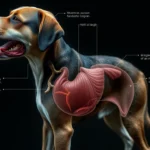
Understanding the health of our beloved dogs is crucial for their overall well-being. One issue that may arise is the formation of styes in their eyes. While many dog owners may not be familiar with this condition, it is essential to comprehend what styes are, their symptoms, causes, and how we can manage and prevent them. This article aims to delve into the question: can dogs get styes? Let’s explore this topic thoroughly.
Understanding Styes
Definition of a Stye
A stye is a common eye condition that can affect both humans and dogs. Medically known as a chalazion or hordeolum, a stye occurs when an oil gland at the base of an eyelash becomes blocked or infected. In dogs, styes may present as external or internal forms.
- External Stye: This is visible on the eyelid and typically appears as a red bump. It results from an infection of the oil glands.
- Internal Stye: This form occurs inside the eyelid and may be less noticeable. It often results from inflammation of the meibomian glands.
Symptoms of Styes in Dogs
Recognizing the symptoms of styes in dogs is vital for timely intervention. Common symptoms include:
- Redness and Swelling: The affected eyelid may appear inflamed and swollen.
- Discharge: Dogs may have discharge that can be watery or purulent.
- Squinting or Excessive Blinking: Your dog may squint or blink more than usual due to discomfort.
- Rubbing of Eyes: If your dog is pawing at their eyes, it could be a sign of irritation.
The severity and presentation of symptoms can vary depending on the breed and age of the dog, as some breeds are more prone to eye issues than others.
Causes of Styes in Dogs
Understanding the underlying causes of styes can aid in prevention. The most common cause is a bacterial infection, particularly from the Staphylococcus bacteria. However, other factors may contribute:
- Allergies: Environmental allergens can cause eye irritation and increase the risk of stye formation.
- Poor Hygiene: Lack of regular cleaning around the eyes can lead to the accumulation of debris and bacteria.
- Underlying Health Issues: Conditions like diabetes may predispose dogs to infections, including styes.
Can Dogs Get Styes?
Overview of Eye Health in Dogs
Maintaining proper eye health is crucial for dogs. Just like humans, dogs can experience a variety of eye conditions, ranging from simple irritations to serious diseases. Regular eye check-ups can help detect potential issues early, allowing for timely interventions.
Evidence and Cases of Styes in Dogs
Research on styes in dogs is limited, but there are documented cases and anecdotal evidence that confirm their occurrence. Veterinarians have observed instances of styes in various breeds, emphasizing the importance of awareness among dog owners.
Risk Factors
Certain breeds are more susceptible to eye issues, including Bulldogs, Pugs, and Shih Tzus. These breeds have unique eye structures that can lead to an increased risk of styes and other ocular problems. Additionally, environmental factors such as exposure to dust, pollen, or chemicals can elevate the chances of stye development.
Diagnosis of Styes in Dogs
Recognizing Symptoms
As a dog owner, being vigilant about your pet’s health is essential. If you notice any signs of a stye, such as redness, swelling, or discharge, it’s crucial to consult your veterinarian. Early recognition can lead to better treatment outcomes.
Veterinary Examination
During a veterinary check-up, the veterinarian will conduct a thorough examination of your dog’s eyes. They may:
- Assess the severity of the stye or any other eye condition.
- Perform diagnostic tests, such as a culture or swab of the discharge, to identify the cause of the infection.
Differential Diagnosis
Accurate diagnosis is critical in managing eye conditions. Other ailments may mimic the symptoms of styes, including conjunctivitis, corneal ulcers, and other infections. Your veterinarian will differentiate these conditions to ensure your dog receives appropriate treatment.
Treatment Options
Home Care and Management
If you suspect your dog has a stye, there are initial steps you can take at home:
- Warm Compresses: Apply a clean, warm compress to the affected eye for 10-15 minutes several times a day. This can help reduce swelling and promote drainage.
- Cleaning: Gently clean around the eyes with a damp cloth to remove any discharge and prevent further irritation.
Veterinary Treatment
If home care does not alleviate the symptoms, your veterinarian may recommend further treatment options:
- Prescription Medications: Antibiotics or anti-inflammatory medications may be prescribed to treat the infection and manage discomfort.
- Surgical Options: In cases where the stye does not respond to medication, surgical drainage may be necessary to remove the blockage.
Follow-Up Care
Follow-up visits to the veterinarian are essential to monitor your dog’s recovery. Be vigilant for signs of complications, such as worsening redness, increased discharge, or persistent squinting.
Preventive Measures
Regular Eye Care
Preventing styes involves maintaining proper eye hygiene:
- Wipe the Eyes: Use a clean, damp cloth to wipe away debris from around your dog’s eyes regularly.
- Regular Check-Ups: Schedule routine veterinary visits to monitor your dog’s eye health.
Dietary Considerations
Nutrition plays a significant role in overall health, including eye health. Ensure your dog has a balanced diet rich in essential nutrients. Consider discussing with your veterinarian about supplements that may support eye health.
Environmental Management
Creating a clean living environment can help reduce the risk of styes:
- Minimize Allergens: Keep your dog’s living area free from dust and allergens.
- Avoid Irritants: Limit exposure to chemicals or substances that may irritate your dog’s eyes.
Conclusion
In summary, understanding whether dogs can get styes is vital for every dog owner. Recognizing the symptoms, knowing the causes, and seeking timely veterinary care are crucial steps in managing this condition. Regular eye care and maintaining a clean environment can significantly reduce the chances of stye development.
Monitoring your dog’s health and being proactive about their eye care will help ensure they lead a happy and healthy life. As always, consult your veterinarian for the best advice tailored to your pet’s specific needs.









